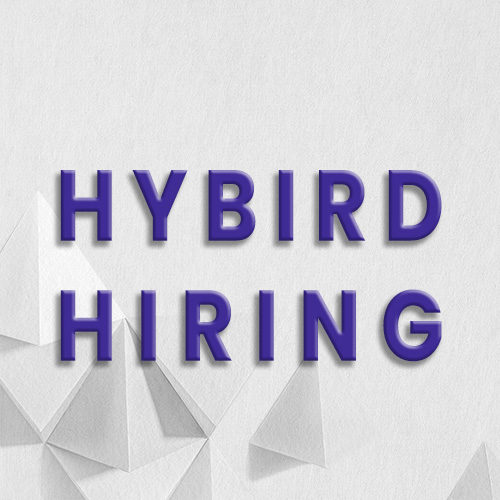Revolutionary Recruitment also known as Hybrid Hiring

'HYBRID HIRING':
Hybrid hiring is a new trend in the recruitment industry that combines the benefits of both traditional and remote hiring methods. This approach has gained popularity in the wake of the COVID-19 pandemic, which has forced many companies to adopt remote work as the new norm. In this blog, we will explore what hybrid hiring is, its advantages, and how it can benefit both companies and employees.
What is Hybrid Hiring?
Hybrid hiring is a combination of traditional and remote hiring methods. In traditional hiring, the entire recruitment process takes place in an office setting where both the candidate and the hiring manager meet face-to-face. Remote hiring, on the other hand, takes place entirely online, where the candidate and the hiring manager communicate through video conferencing or other digital platforms. Hybrid hiring combines both methods, where some parts of the recruitment process are conducted in person, while others are conducted remotely.

Advantages of Hybrid Hiring
Increased Diversity: Hybrid hiring opens up new opportunities for companies to hire candidates from a wider pool of applicants. With remote hiring, companies can expand their search beyond geographical borders and find the best candidate for the job, regardless of location.
Increased Flexibility: Hybrid hiring allows both companies and employees to have more flexibility in the recruitment process. Candidates can take part in in-person interviews without having to travel while hiring managers can assess candidates' skills and cultural fit without being limited by geographical boundaries.
Improved Work-Life Balance: Hybrid hiring can lead to improved work-life balance for employees. By allowing remote work, employees can work from the comfort of their own homes and have more control over their schedules, leading to reduced stress and increased job satisfaction.
Cost Savings: Hybrid hiring can also lead to cost savings for companies. By reducing the need for travel and office space, companies can reduce their overhead costs and invest more in employee benefits and training programs.
How Hybrid Hiring Can Benefit Both Companies and Employees
Increased Productivity: By allowing employees to work from the comfort of their own homes, hybrid hiring can increase employee productivity. Studies have shown that remote workers are more productive and take fewer breaks than those who work in traditional office settings.
Better Talent Retention: Hybrid hiring can also improve talent retention for companies. By offering flexible work arrangements, companies can attract and retain the best talent and reduce employee turnover.
Better Hiring Decisions: Hybrid hiring allows companies to make more informed hiring decisions by giving them access to a broader pool of applicants and by enabling them to assess candidates' skills and cultural fit in a more comprehensive manner.
Improved Employee Satisfaction: Hybrid hiring can also lead to improved employee satisfaction. By offering flexible work arrangements, companies can help employees balance their work and personal lives, leading to reduced stress and increased job satisfaction.
In conclusion, hybrid hiring is a trend that is here to stay. With its numerous advantages, it is clear that this approach can benefit both companies and employees. Whether you are a hiring manager or a job seeker, it is essential to understand the benefits of hybrid hiring and how it can help you achieve your goals.

